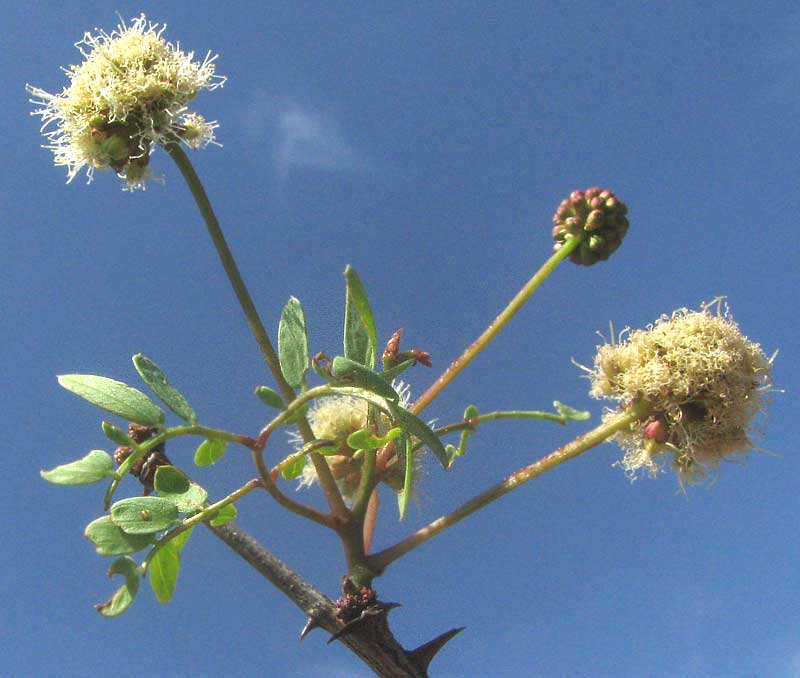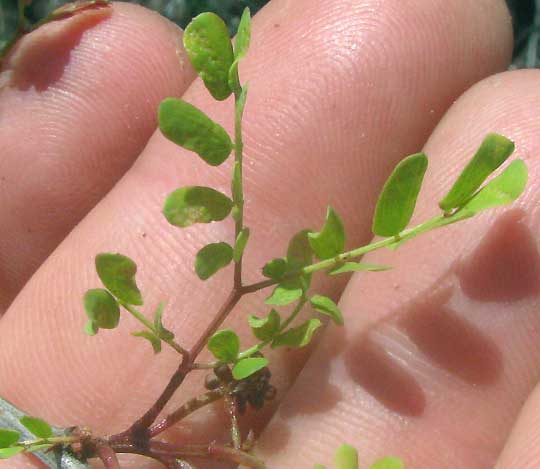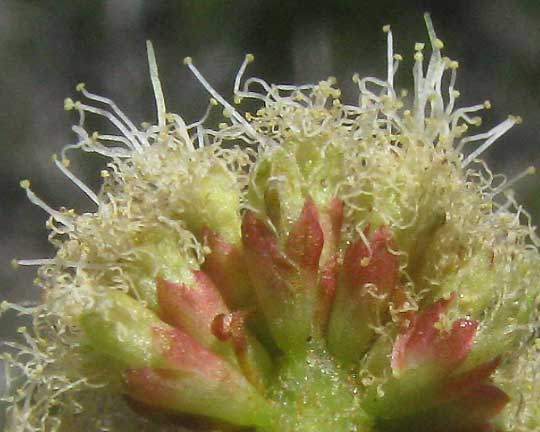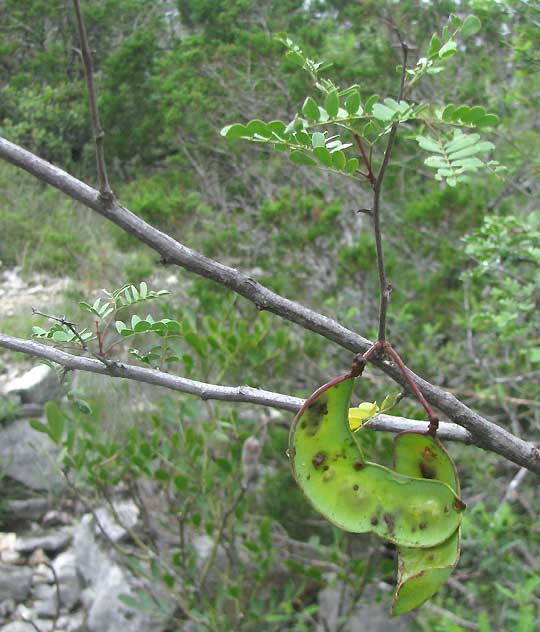Excerpts from Jim Conrad's
Naturalist Newsletter

from the March 24, 2013 Newsletter issued from the valley of the Dry Frio River in northern Uvalde County, southwestern Texas, on the southern border of the Edwards Plateau; elevation ~1750m (~5750 ft); N29.62°, W99.86°; USA
CATCLAW FLOWERING
In very thin, dry soil atop our rocky-topped, limestone hills you find plants not growing below on the slopes or in the valley. The plants are highly adapted to alkaline soil that's normally extremely dry, and to temperature extremes and abundant sunlight. Nowadays atop the limestone hill to our south there's a wiry, spiny bush or small tree a little over head high issuing its leaves and opening its flowers, as you can see above.
Notice at the picture's bottom the thick-based, backward projecting, low spines. Also, occupying the picture's lower, left quarter you can see the tree's twice-compound leaf -- a single leaf in which the primary divisions are themselves divided into small leaflets, or pinnae. A shot better displaying a leaf's basic structure and conveying its smallness is shown below:

The plant's spherical, white, fuzzy flowering heads consist of numerous closely packed flowers. A cross-section of a head is shown below:

In that picture the reddish things are the flowers' calyxes, each calyx bearing five red, sharp-pointed sepals. If you look closely you can see that each calyx surrounds the base of a cream-colored or very pale yellow corolla with five lobes. The white, fuzzy things issuing from inside each corolla are stamens tipped with tiny, yellowish, globose, pollen-producing anthers.
In the Yucatan we learned that spiny trees with such twice-pinnate leaves and flowering heads composed of closely packed flowers containing more than ten stamens... is an acacia. But there are many acacias, over 1300 according to some estimates, and their taxonomy is in much debate, so figuring out that you have an acacia still leaves you a long way from enlightenment.
Judging from lists of species collected in our area and pictures on the Internet -- for the Flora of North America's acacia section isn't finished yet -- our currently flowering acacia appears to be ACACIA ROEMERIANA*, known by several English names, including Roundflower Catclaw, Roemer Acacia, Catclaw Acacia and just Catclaw. Many different species of bushes and small trees with backward pointing, broad-based spines are called catclaws.
Our Acacia roemeriana is semi-evergreen, with woody stems presently mostly leafless, but with a few of last year's dark-green leaves still attached to lower stems, even as new leaves unfold along with the opening flowers.
As with other acacias, this one's small flowers produce nectar much appreciated by a variety of bees and other pollinators.
Acacia roemeriana is described as living on dry soil of limestone hills in southern Texas, New Mexico, and arid northeastern Mexico.
from the June 9, 2013 Newsletter issued from the valley of the Dry Frio River in northern Uvalde County, southwestern Texas, on the southern border of the Edwards Plateau; elevation ~1750m (~5750 ft); N29.62°, W99.86°; USA
CATCLAW LEGUMES
Nowadays the Catclaw's white, spherical flower-heads have given way to fairly distinctive looking fruits, shown below:

Since acacias are members of the big Bean Family, the pod-type fruits are legumes, and the seeds they contain can be called beans. You can see how the legumes are exceptionally flat but wide, somewhat curved, and bear conspicuous, wire-like sutures along each side where the legume ultimately will split. In the picture you can also see that each pod contains relatively few, fair-sized and widely spaced beans.